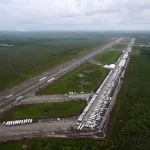
ODESA, Ukraine — New shipments of U.S. ammunition have begun to flow into Ukraine after a political dispute led to months of painful shortages, but Ukrainian forces still feel a “hunger” for ammunition and have misgivings about the quality of American support.
“Part of it has arrived, but the thing is that the U.S. does not really understand how much artillery shells we need on our front line,” Mamuka Mamulashvili, commander of the Georgian Legion in Ukraine, told the Washington Examiner on the sidelines of the Black Sea Security Forum. “We are using the artillery shells that are given to us a lot faster than they think we could use them. So, [there is] so-called artillery hunger, and we’re having the problems because of that, because when we don’t have enough ammunition to shoot, more professionals are dying, and we are getting weaker.”
Mamulashvili, the son of a Georgian general and founder of Ukraine’s largest foreign fighting force, attested to the costs of Western defense industry shortcomings as Russian forces enjoy a substantial artillery advantage in Europe’s largest conflict since the Second World War. Those difficulties were exacerbated by House Republican attempts to use the Ukraine aid legislation as leverage to demand border security policy changes. Yet the White House’s victory in that protracted political dispute hasn’t allayed misgivings that President Joe Biden is hesitant to authorize the kind of assistance required to give Ukrainian forces a real chance at victory.
UKRAINE DEBATES WHETHER TO CONSCRIPT CLERGY AS RUSSIA WAR RAGES
“Whatever they send should be on time … because when it’s later, [then] there is no guy who knows how artillery works at all, and we’re going to lose the war this way,” Mamulashvili said. “And we don’t want a weapon just, you know, to stop [the Russians] and hold the front line. We need a weapon to [go on] offense and to kick them out of the occupied territories.”
Risk-averse White House
Biden’s willingness to support such an effort remains in doubt. Secretary of State Antony Blinken insisted during a recent visit to Kyiv “that the United States is committed to helping ensure Ukraine winning this war,” but White House officials have a reputation in Central and Eastern European policy circles for taking a risk-averse approach to support for Ukraine. For instance, Biden lagged behind countries such as Poland and the Czech Republic in sending tanks and artillery to Ukraine and has hesitated to transfer long-range missiles to Ukraine while requiring Ukraine to promise not to use American-made weapons against most Russian targets in Russian territory.
“A military victory is not going to be easy, but we haven’t even, frankly, tried,” the Foreign Policy Research Institute’s Robert Hamilton, a career Army veteran and former Army War College professor, said during one of the weekend’s panel discussions. “The amount of equipment, the type of equipment we’ve given, and the restrictions we’ve put on it have made a military victory impossible for Ukraine.”
Those complaints have rumbled around the military aid shipments from the earliest weeks of the full-scale invasion, as Biden weighed U.S. interests in supporting Ukraine against his stated fear that the conflict could give rise to a “third world war.” Russian President Vladimir Putin regards his arsenal of relatively low-yield atomic bombs as a possible battlefield weapon, according to Western officials, but Ukrainian personnel and Western proponents of more assistance to Ukraine believe the Biden team is overanxious about that risk.
“When it comes to nuclear weapons, it’s not just [a matter of] Putin opens some box and just pushes some button. At least five, seven other people should be involved,” Ukrainian Col. Mykhaylo Tretiak told the conference. “These are just knowledgeable people, and they understand perfectly well the consequences. That’s why it is not enough to have the will of one person in the leadership of the Kremlin. … There is a threat, but there are a lot of factors for these weapons to be used.”
U.S. officials have signaled they perceive Putin is most likely to use nuclear weapons in a scenario in which Ukrainian forces were able to threaten his hold on Crimea, the traditional home of Russia’s Black Sea Fleet that Russian forces seized from Ukraine when they began the war in 2014. Tretiak is an officer in Ukraine’s naval drones program, a new weapons system that Ukrainian forces have developed and deployed to devastating effect against Russian ships.
“Look at the Black Sea: Look at [the] huge success that Ukraine has in the Black Sea where our hands are untied, where we can show our creativity, where we can fight in the way we want to,” Oleksii Goncharenko, a Ukrainian lawmaker from Odesa and the lead organizer of the forum, told the assembled guests on Friday. “Nobody would believe in this several years ago.”
Low-cost drones a watershed moment

The emergence of drones as a low-cost and effective weapon of war strikes officials and observers as a watershed moment in military history. Tretiak proposed that “we are standing on the [threshold] of the drones war [era], when drones will fight against each other.” And the rapid pace of innovation could continue to change the balance of military power in the current war.
“This is a totally new war,” former Ukrainian defense minister Andriy Zagorodnyuk said last week at a Carnegie Endowment event. “The proliferation of the unmanned systems is just completely unprecedented. … And so, all our strategies which we need to develop, internally and with our allies, they need to reflect the fact that the war is not going to be like it was two years ago, probably never [again].”
Mamulashvili’s battalion, a component of Ukraine’s Defense Intelligence directorate, already has internalized that lesson. “It is [the] future of the war, and we are modernizing whatever we have,” he said. “Guys are even inventing drones themselves.”
Still, those drones are not yet a substitute for U.S.-made long-range missiles. Ukrainian commanders aspire to destroy Russian forces and military supplies well before they approach the front lines.
“If we [want] to win this war, we have to get ATACMS, we need operational freedom,” Mamulashvili said. “We need to shoot them on Russian territory because most of the logistics for Russian artillery shells and ammunition are on a border with Ukraine, on [the] Russian side.”
CLICK HERE TO READ MORE FROM THE WASHINGTON EXAMINER
Biden has banned the use of American weapons in Russia, although he softened the restriction recently after Russian forces began a protracted assault on Kharkiv, a major city near the Ukrainian border with Russia.
“The disease of our age is that we don’t have any more Reagans,” he said. “We don’t have guys who are not scared that Putin will use nuclear weapons.”
Scroll down to leave a comment:







